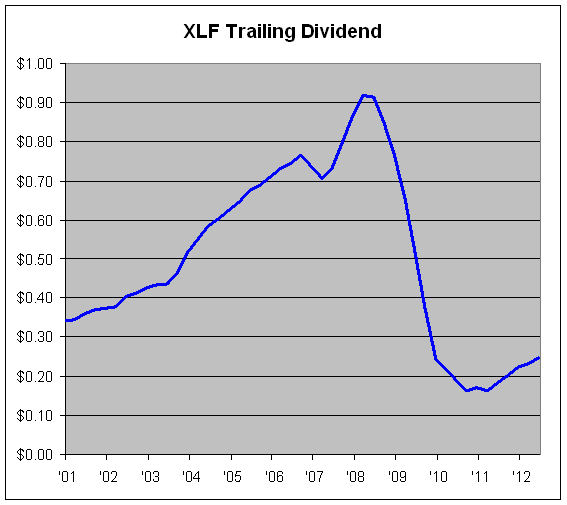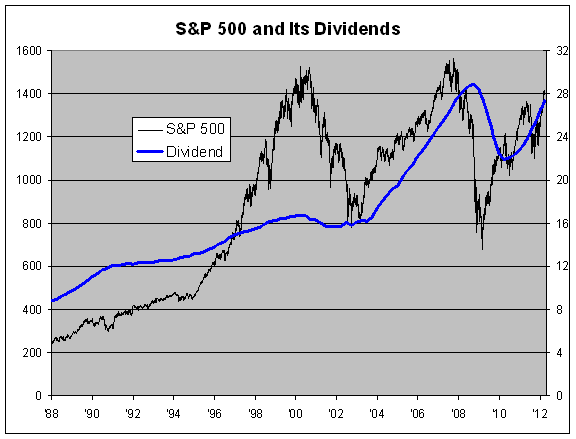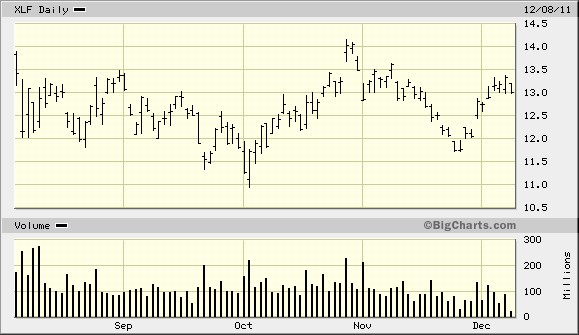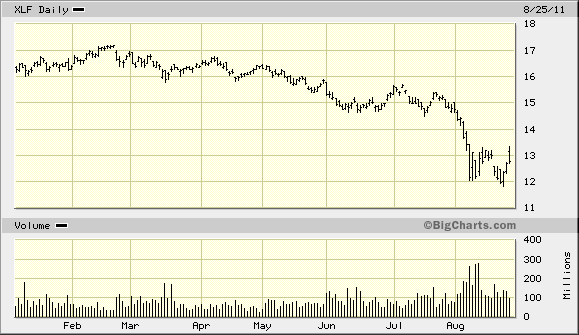Posts Tagged ‘XLF’
-
The Return of Financial Dividends
Eddy Elfenbein, June 19th, 2012 at 10:39 amDividends are slowly making a comeback, and they’re even returning to the financial sector. Thanks to the TARP program, many financials firms weren’t allowed to pay dividends, or they cut them down to a trivial amount.
The Financial Sector ETF ($XLF) just paid out its June dividend of 6.8 cents per share. That’s a 28% increase over the 5.3 cents from one year ago. This is still well below the peak when the XLF regularly paid out more than 20 cents every quarter.
Profits are returning and so are dividends. If all goes well, I think the XLF could pay out 30 cents per share this year. At $15, that’s a yield of 2% which is lower than many stocks. However, the XLF has the ability to increase its dividends at a rapid clip for the next few years.
-
Dividends Are Making a Comeback
Eddy Elfenbein, April 3rd, 2012 at 11:04 amNow that the first quarter is over, we have some stats on dividends. The S&P 500 paid out 7.09 in dividends (that’s the number adjusted for the index) which is a 15.06% increase over the first quarter of 2011.
I think this will be a very good year for dividends, especially with the dividend news from Apple ($AAPL). The market also responded very well to the five-fold dividend increase from CA Technologies ($CA), plus the recent increase at JPMorgan ($JPM). So far this year, there have been 122 dividend increases in the S&P 500, plus seven new dividend payers. Only three companies have lowered their payouts.
Looking at dividends has been a surprisingly good way of valuing the market over the past few years. You can never be quite sure about a company’s earnings or cash flow since accounting rules allow for enormous latitude. But if a company is willing to send shareholders a check, you can be pretty certain those numbers are legit (though not always).
Dividends also tend to be very stable. Once a company raises its quarterly dividend, there’s an implicit understanding that that’s the new level. Shareholders will put up with a lot, but they do not like cuts in dividends, and woe be unto the company that lowers their payout. The recent recession, however, saw an unusually higher number of cut dividends or suspended payouts altogether. In 2009, annual dividends dropped by 21%. Contrast this with 2001 when the stock market crash led to dividends falling by just 3%.
The lower dividends this time around have been largely concentrated in the financial sector. Part of this is due to rules around receiving TARP payments. I don’t have the exact numbers for the financial sector but the quarterly dividends for the Financial Sector ETF ($XLF) fell about 70%. The Financial Sector currently makes up 15% of the S&P 500.
The good news is that higher profits are leading to higher dividends. Dividends are on pace to hit a new record this year. On top of that, the dividend payout ratio—the percent of profits paid out as dividends—is still below 30% which is far below normal.
Here’s a look at the S&P 500 in the black line along with its dividends in the blue line. The black line follows the left scale and the blue line follows the right. The two lines are scaled at a ratio of 50-to-1 which means that the S&P 500 yields exactly 2% whenever the lines cross.
I think the chart shows some interesting facts. For example, you can see how different the market crashes of 2000-01 and 2008-09 were. In the first, prices soared above fundamentals. In the latter, fundamentals crumbled beneath the price. From 2003 to 2007, stock prices generally followed the trend in dividends. We can also see how much investors panicked during the financial crisis. In March 2009, the S&P 500’s dividend yield eventually reached 4%.
I asked Howard Silverblatt, the head stat guy at S&P, to tell me the dividend estimate for this year. He said it’s $29.70. To equal a dividend yield of 2%, the S&P 500 needs to get to 1,485 which is a 4.6% jump by the end of the year.
-
A Turnaround for Financials
Eddy Elfenbein, December 8th, 2011 at 10:48 amI’ve been pretty down on financials for the past several months, but I think the sector is finally a good buy. Two months ago, I said that the Financial Sector ETF ($XLF) would be a good speculative buy if it fell below $12 per share. Eventually it did. On October 3, the XLF got as low as $10.95. I think it has a reasonable shot of hitting $16 within the next 12 months. In early 2007, the ETF came close to $37.
-
Greece Gets Ready to Default
Eddy Elfenbein, September 12th, 2011 at 12:20 pmThe stock market is down yet again today. The S&P 500 got as low as 1,141.53 today so it’s still above the August 8th closing low of 1,119.46. One interesting aspect of today’s sell-off is that gold is also down today.
The financial markets are beginning to adjust to the reality that Greece is going to default. Forbes writes: “Last week five-year Greek credit-default swaps indicated a 92% chance that the country would miss its debt payments.” This is having major spillover effects. The euro has been clobbered against the dollar and many other currencies. Now it looks like French banks are in serious trouble as Moody’s is considering downgrading them.
The National Association for Business Economics today cuts its forecast for U.S. GDP growth. They see the economy growing by 1.7% this year and 2.3% next year. That’s down from their earlier estimates of 2.8% for this year and 3.2% for 2012.
The Financial Sector ETF ($XLF) bounced off $12 per share. If it breaks below $12, I think it will be an outstanding buy. I also see that Nicholas Financial ($NICK) dropped below $10 per share which is less than its book value of $10.18.
-
The Financial Spyders ETF
Eddy Elfenbein, August 25th, 2011 at 11:47 amThe $XLF has crashed and burned recently. But just because it’s down doesn’t mean that it’s cheap. It’s just cheaper than it was. Expect another test of $12 soon.
-
-
Archives
- June 2025
- May 2025
- April 2025
- March 2025
- February 2025
- January 2025
- December 2024
- November 2024
- October 2024
- September 2024
- August 2024
- July 2024
- June 2024
- May 2024
- April 2024
- March 2024
- February 2024
- January 2024
- December 2023
- November 2023
- October 2023
- September 2023
- August 2023
- July 2023
- June 2023
- May 2023
- April 2023
- March 2023
- February 2023
- January 2023
- December 2022
- November 2022
- October 2022
- September 2022
- August 2022
- July 2022
- June 2022
- May 2022
- April 2022
- March 2022
- February 2022
- January 2022
- December 2021
- November 2021
- October 2021
- September 2021
- August 2021
- July 2021
- June 2021
- May 2021
- April 2021
- March 2021
- February 2021
- January 2021
- December 2020
- November 2020
- October 2020
- September 2020
- August 2020
- July 2020
- June 2020
- May 2020
- April 2020
- March 2020
- February 2020
- January 2020
- December 2019
- November 2019
- October 2019
- September 2019
- August 2019
- July 2019
- June 2019
- May 2019
- April 2019
- March 2019
- February 2019
- January 2019
- December 2018
- November 2018
- October 2018
- September 2018
- August 2018
- July 2018
- June 2018
- May 2018
- April 2018
- March 2018
- February 2018
- January 2018
- December 2017
- November 2017
- October 2017
- September 2017
- August 2017
- July 2017
- June 2017
- May 2017
- April 2017
- March 2017
- February 2017
- January 2017
- December 2016
- November 2016
- October 2016
- September 2016
- August 2016
- July 2016
- June 2016
- May 2016
- April 2016
- March 2016
- February 2016
- January 2016
- December 2015
- November 2015
- October 2015
- September 2015
- August 2015
- July 2015
- June 2015
- May 2015
- April 2015
- March 2015
- February 2015
- January 2015
- December 2014
- November 2014
- October 2014
- September 2014
- August 2014
- July 2014
- June 2014
- May 2014
- April 2014
- March 2014
- February 2014
- January 2014
- December 2013
- November 2013
- October 2013
- September 2013
- August 2013
- July 2013
- June 2013
- May 2013
- April 2013
- March 2013
- February 2013
- January 2013
- December 2012
- November 2012
- October 2012
- September 2012
- August 2012
- July 2012
- June 2012
- May 2012
- April 2012
- March 2012
- February 2012
- January 2012
- December 2011
- November 2011
- October 2011
- September 2011
- August 2011
- July 2011
- June 2011
- May 2011
- April 2011
- March 2011
- February 2011
- January 2011
- December 2010
- November 2010
- October 2010
- September 2010
- August 2010
- July 2010
- June 2010
- May 2010
- April 2010
- March 2010
- February 2010
- January 2010
- December 2009
- November 2009
- October 2009
- September 2009
- August 2009
- July 2009
- June 2009
- May 2009
- April 2009
- March 2009
- February 2009
- January 2009
- December 2008
- November 2008
- October 2008
- September 2008
- August 2008
- July 2008
- June 2008
- May 2008
- April 2008
- March 2008
- February 2008
- January 2008
- December 2007
- November 2007
- October 2007
- September 2007
- August 2007
- July 2007
- June 2007
- May 2007
- April 2007
- March 2007
- February 2007
- January 2007
- December 2006
- November 2006
- October 2006
- September 2006
- August 2006
- July 2006
- June 2006
- May 2006
- April 2006
- March 2006
- February 2006
- January 2006
- December 2005
- November 2005
- October 2005
- September 2005
- August 2005
- July 2005




 Eddy Elfenbein is a Washington, DC-based speaker, portfolio manager and editor of the blog Crossing Wall Street. His
Eddy Elfenbein is a Washington, DC-based speaker, portfolio manager and editor of the blog Crossing Wall Street. His